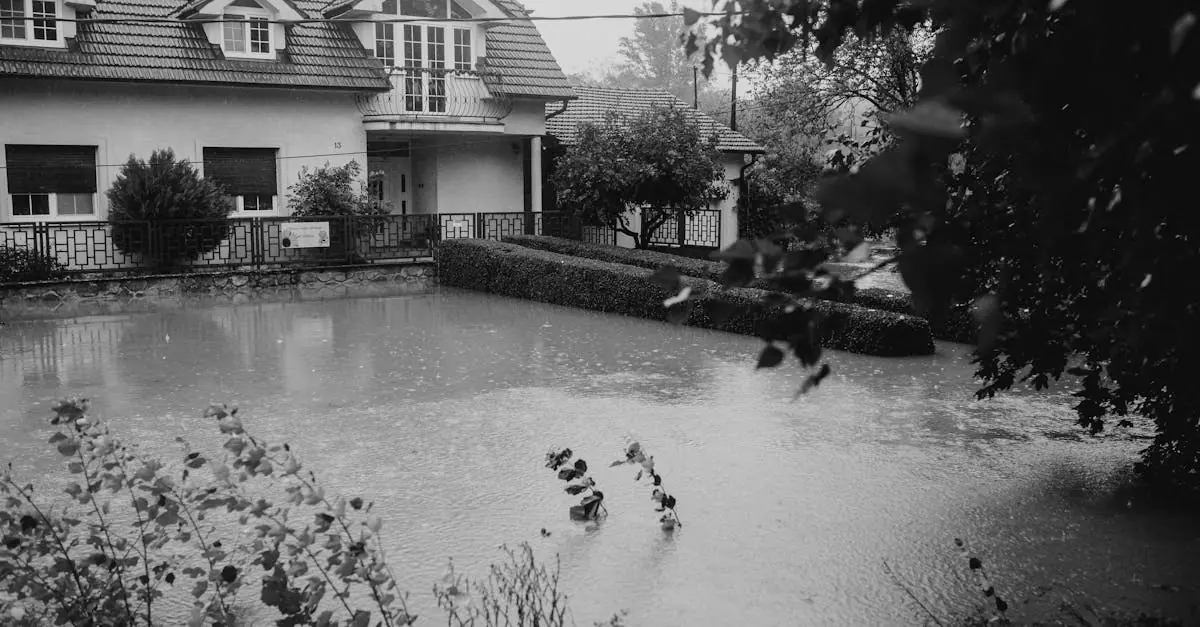Table of Contents
ToggleWhen the wind starts howling and your roof begins to resemble a scene from a disaster movie, the last thing on anyone’s mind is whether their homeowners insurance has their back. But let’s face it—nobody wants to play the blame game with Mother Nature. So, is wind damage covered by homeowners insurance? Spoiler alert: it can be, but it’s not as straightforward as a gentle breeze on a sunny day.
Navigating the world of homeowners insurance can feel like trying to find your way through a maze during a tornado. With policy exclusions and fine print lurking around every corner, you might wonder if your coverage includes that pesky wind damage. Fear not! This article will help clarify the ins and outs of your insurance policy, ensuring you know exactly what to expect when the winds of change come blowing through your neighborhood.
Understanding Homeowners Insurance
Homeowners insurance provides essential protection for property owners. Policies vary significantly, especially regarding coverage for damages caused by wind.
Types of Coverage
Many homeowners insurance policies include dwelling coverage, which protects the structure of the home. Personal property coverage addresses damage to belongings within the house. Liability coverage offers protection against legal claims for injuries or damages to others. Additional living expenses coverage is critical in cases where homeowners must temporarily relocate due to extensive repairs. Commonly, wind damage falls under dwelling coverage, but specific terms can differ among insurers.
Exclusions in Policies
Homeowners often encounter exclusions that can complicate claims. Typical exclusions include damage from flooding and neglect, which can affect wind-related claims. Policies might not cover certain types of wind damage, such as that resulting from a lack of maintenance. Furthermore, some regions mandate separate windstorm insurance due to heightened risks. Understanding these exclusions is vital to ensure homeowners are prepared for any wind-related damage challenges.
Is Wind Damage Covered by Homeowners Insurance?
Wind damage coverage in homeowners insurance often varies among policies. Many homeowners discover that while their policies generally offer protection, specific terms can differ.
Standard Coverage for Wind Damage
Standard homeowners insurance typically includes coverage for wind damage under dwelling protection. This protection applies to the structure of the home, which encompasses roofs, walls, and attached outdoor features. Homeowners filing claims may find that damage caused directly by wind, such as torn shingles, is often eligible for reimbursement. However, exclusions exist, particularly regarding subsequent damage from rain entering through wind-damaged areas. Understanding the Fine Print is crucial, as homeowners must know precisely what is and isn’t covered.
Factors Affecting Coverage
Several factors influence wind damage coverage in homeowners insurance policies. Geographic location plays a significant role, as areas prone to severe weather events may face higher scrutiny. Additionally, the specific policy chosen affects the extent of coverage, including deductibles and maximum payouts. Homeowners may also encounter limitations based on the home’s age and pre-existing conditions. Insurers often assess the condition of the property before underwriting policies, reflecting the risk they assume. When evaluating insurance options, homeowners must consider these factors to secure adequate protection against wind-related damage.
What to Do If You Experience Wind Damage
Experiencing wind damage can be overwhelming. Taking immediate action is crucial to ensure proper recovery and protection.
Documenting the Damage
Start by assessing the damage thoroughly. Take clear photographs from multiple angles to capture the extent of the destruction. Creating a detailed list of damaged items is also helpful. Include descriptions, costs, and any relevant receipts. Document any temporary repairs, like tarping a roof, to prevent further issues. This information is vital when presenting your claim to the insurance provider. Timely documentation supports effective communication with the insurer, increasing chances for approval.
Filing a Claim
Filing a claim promptly is essential. Contact the insurance company directly to report the wind damage. Be prepared to provide policy information and details about the incident. Following the initial report, fill out any required claim forms accurately, attaching all gathered documents. Understand the timeline for claim submissions, as late filings may lead to denial. Regularly follow up with the insurer to check on the status of the claim. Keeping organized records of all communications enables smoother interactions throughout the claims process.
Tips for Homeowners
Homeowners can take proactive steps to protect their properties and understand their insurance coverage better. These tips provide essential guidance for dealing with wind damage and improving preparedness.
Reviewing Your Insurance Policy
Understand the specifics of your homeowners insurance policy. Check for coverage details related to wind damage and note any exclusions. Verify dwelling coverage limits, which include protection for structures like roofs and walls. Consider any additional riders or endorsements available for your area. Many policies exclude damages like flooding that may follow wind damage, so knowing these details assists in managing expectations. Review your policy annually to ensure it meets your evolving needs. Engage with your insurance agent to clarify any concerns about coverage or risks in your area.
Preparing for Future Storms
Take essential steps to prepare your property for severe weather events. Reinforce roofing materials and ensure proper drainage to protect against wind damage. Trim trees and bushes near the home to reduce risks from falling branches. Install storm shutters or impact-resistant windows to provide additional protection. Develop an emergency plan, including evacuation routes and a communication strategy for family members. Stock essential supplies like flashlights, batteries, and non-perishable food items. Regularly practice your emergency plan to ensure everyone knows their roles during a storm. This preparation enhances safety and can mitigate the impact of wind damage on your home.
Understanding wind damage coverage in homeowners insurance is essential for every homeowner. Policies can vary greatly and often include specific exclusions that might surprise many. By knowing what to look for in their insurance documents and discussing concerns with their agents, homeowners can ensure they’re adequately protected.
Taking proactive steps to secure their properties can also make a significant difference. Documenting damage thoroughly and filing claims promptly will help streamline the recovery process. With the right knowledge and preparation, homeowners can navigate the complexities of wind damage coverage and safeguard their homes against future storms.





